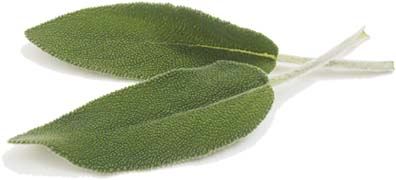

Key Ingredient

|
Sage
The aroma of sage goes hand-in-hand with the Thanksgiving holiday. For some, the flavor of sage is overpowering, but for those who appreciate this unique herb's pungency, there is no other way to season the holiday meal.
The basics: Sage is an ancient herb that originated in the Mediterranean. It is a member of the mint family and has been used for culinary and medicinal purposes for centuries.
The most popular of the many varieties of sage are the common green sage, purple sage and pineapple sage. Green and purple sage are used most often to flavor meats and poultry, while pineapple sage, from Central America, is used in infusions, teas and potpourri.
Green sage has delicate, elongated, grayish-green leaves with a fuzzy texture. The flavor is rather strong and slightly bitter. Except for Thanksgiving, the herb is not highly favored in this country. In Spain, Greece and Italy, however, sage is used to flavor meats in much the same manner as rosemary.
Selecting: Fresh sage can generally be found year-round in supermarkets. Because sage deteriorates quickly after harvesting, watch out for black or wilting leaves that will mold rapidly.
Storing: Use fresh sage immediately after purchasing, or store in the refrigerator for a day or two at most.
Use: A little sage goes a long way. Sage is very aromatic and will bring a strong flavor to meat and poultry dishes or stuffings.
Fresh sage leaves can be used whole for seasoning turkey, either placed near the breast under the skin or stuffed in the cavity with other herbs and vegetables. Sage can also be chopped and added to stuffings or to flavor most poultry-based soups.
Sage is also ideal for pork and beef dishes. The Italians use the herb to kick up veal, which is considered bland, or they simply brown the leaves with butter for a hearty sage-butter and gnocchi dish.
If substituting dried sage, be sure to use sparingly.
Where to buy: Fresh sage is available in the herb section of produce aisles and runs $1.89 to $1.99 an ounce. If fresh sage is unavailable, dried sage is sold bottled in coarse ground or powdered form, at $3 to $5 for a half ounce.
Food Stuffs: Morsels
Eleanor Nakama-Mitsunaga is
a free-lance food writer. Contact her
online through features@starbulletin.com